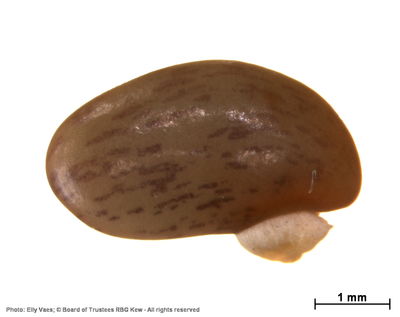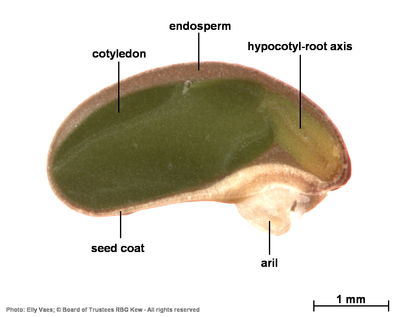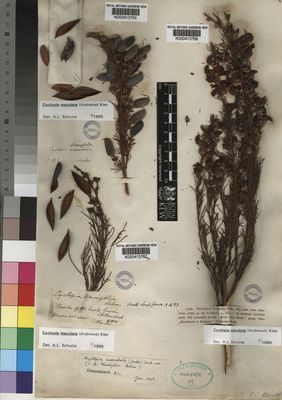Legumes of the World. Edited by G. Lewis, B. Schrire, B. MacKinder & M. Lock. Royal Botanic Gardens, Kew. (2005)
-
Note
-
Schutte & Van Wyk (1998a) summarised recent changes to generic and tribal circumscriptions in the Podalyrieae and Liparieae. The Liparieae has been formally placed in synonymy under Podalyrieae, as was also suggested by Polhill (1981o: 396–397, 398) and Käss & Wink (1997), but the genus Hypocalyptus was excluded and given tribal status as the Hypocalypteae (Schutte & Van Wyk, 1998b). The genus Coelidium Vogel ex Walp. was subsequently reduced to synonymy within Amphithalea Eckl. & Zeyh. (Schutte, 1998). This treatment follows Van Wyk & Schutte (1995a) but reflects several more recent modifications and revisions (references given below). Species in the tribe are listed by Nkonki et al. (2003). As presently circumscribed, the tribe includes 8 genera and 125 species (Fig. 35).
It is interesting to note that taxonomic modifications based on detailed analyses of morphology, cytology and chemistry (Schutte & Van Wyk, 1998a & b) have subsequently been supported by molecular evidence (e.g., Crisp et al., 2000; Van der Bank et al., 2002; Wink & Mohammed, 2003). Secondary metabolites have contributed substantially to the current generic and tribal concepts. These include, amongst others, the presence of unique quinolizidine and piperidyl alkaloids, the absence of canavanine, the absence of proanthocyanidins and the presence of esters of hydroxylated anthocyanins in purple-flowered taxa. A clear-cut dichotomy (sprouting versus non-sprouting) exists in the fire-survival strategy of many mediterranean shrubland legumes and this feature is particularly relevant in the Podalyrieae (Schutte et al., 1995).
The Podalyrieae belongs to a monophyletic clade, the ‘core genistoids’ which includes Crotalarieae, Genisteae, Podalyrieae, Thermopsideae, Euchresteae and Sophoreae sens. strict. (Crisp et al., 2000; Pennington et al., 2001; Wojciechowski et al., 2004). In Crisp et al. (2000) and Wink & Mohamed (2003), Podalyrieae is sister to a clade comprising the Old World Crotalarieae and the Genisteae, the latter incorporating the ‘African Genisteae’, i.e. Argyrolobium, Dichilus, Melolobium and Polhillia (see Van Wyk & Schutte, 1995a). Cadia (in Sophoreae sens. lat.) is basally branching to Podalyrieae in the analysis of Kajita et al. (2001) and Wink & Mohamed (2003), and the Podalyrieae-Crotalarieae-Genisteae clade is sister to a Thermopsideae-Sophoreae sens. strict. clade.
A distinct genus with intricate infrageneric relationships; it appears to be an isolated basally branching group within the Podalyrieae (see Van der Bank et al., 2002)
-
Habit
-
Shrubs
-
Ecology
-
Mediterranean shrubland (fynbos and forest margins), often localised at high altitudes, in rocky and sandy areas
-
Distribution
-
S Africa (endemic to the Cape region)






